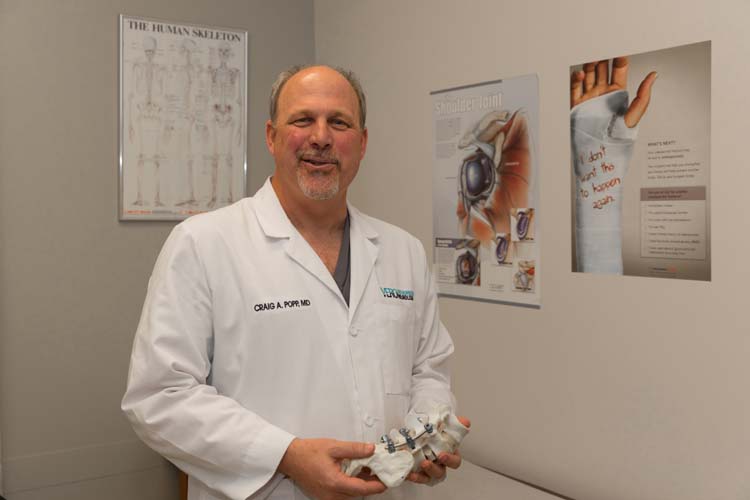
Dr. Craig Popp, a board-certified and fellowship-trained orthopedic surgeon with Vero Orthopaedics & Neurology, isn’t likely run out of patients anytime soon.
That’s because, according to both the National Institutes of Health and Johns Hopkins Medicine, nearly 80 percent of U.S. adults experience back pain and 50 percent experience neck pain.
And, according to the Centers for Disease Control, those problems get more common – and painful – as we age.
Diagnosing the exact cause of back pain can be something of a medical Rubik’s cube. There are 33 separate vertebrae in the human spine in five separate regions – the cervical, thoracic, lumbar, sacrum and coccyx – and more than 20 vertebral disks along with many muscles, ligaments, tendons and nerve bundles – and all those individual elements must work collaboratively.
When they don’t the result can be pain, sometimes severe.
It can be neck pain, lower back pain, middle back pain, upper back pain, low back pain with sciatica, leg pain or some other bone, nerve and muscular problem such as lumbar radiculopathy, spinal instability, spinal stenosis, arthritis, compression fractures, osteoporosis, slipped or herniated discs, scoliosis and spondylolisthesis.
In fact, according to the Mayo Clinic, two of the top three reasons people in this country go to see a doctor are back pain-related.
Popp, who has nearly 20 years of experience in this field, says the best way to find the cause of an individual’s back pain isn’t by individually examining each of the 50-some bones and disks in the spine.
“The way I approach it,” he says, “is basically talking to the patient; getting to know the patient.
“Eighty-five percent [of making the right diagnosis has to do with] taking a history – and listening.”
Popp says “the vast majority of people [having an episode of back pain] get better without any sort of intervention.” But if medical intervention is needed, he is confident about his own skill set and those of his colleagues at Vero Orthopaedics.
In any event, Popp says, “I’m very fortunate here – it’s almost like a comprehensive spine program. I have individuals that can do the injections, I have individuals that can do nerve conduction tests. I have a neurologist that can weed out some of those other unusual type of conditions.
“Then we have Dr. [Seth] Coren. I see a lot of patients with compression fractures in their back, and while I used to do some osteoporosis work before, now I have an individual who really concentrates on that type of thing” just down the hall.
Popp says the net result of having so many talented colleagues in one location “is that I can quickly differentiate things by obtaining certain types of tests right within the office.”
Popp continues by saying, “I think one of the most common problem people have, and it’s probably the No. 1 people seek medical care, is just a simple lumbar strain. Low-back pain. A lot of those individuals will have leg pain associated with it, and if they have enough leg pain, or they have instability in their spine, that’s when surgical intervention becomes necessary.”
Spinal surgery is – obviously – serious business, but Popp points to major improvements in both the technology and the procedures in use today.
“The nice thing is technology has allowed us to really define what the pain generator is,” he explains, “with the imaging techniques, the image-guidance techniques and use of microscopes, you can really limit the scope of the surgery that you have to do.”
And since Popp favors a minimally invasive approach to most surgeries, he adds, “having the right retractors, the right kind of tubes to work through, and the right imaging modalities available really allow you to do more in less space.”
Asked if he a “favorite” procedure, Popp pauses briefly and says “I like to do the procedure that makes the patient feel the best.”
When pressed for a more specific response, he adds. “I do like a nice microdiscectomy. If lumbar disc is putting pressure on the nerve root and that patient is just dying in pain and you take the pressure off the nerve root and they feel really good,” that, he says smiling, “is really rewarding.”
Dr. Craig Popp is with Vero Orthopaedics & Neurology at 1155 37th Lane in Vero Beach. The phone number is 772-569-2330.



